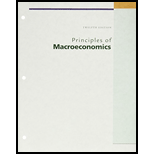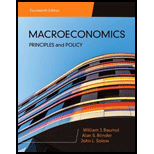
Subpart (a):
To show the effect of each event on the current account balance and the exchange rate.
Subpart (a):
Explanation of Solution
The US government cutting tax rate is an expansionary fiscal policy. When the exchange rates are fixed, an expansionary fiscal policy leads to an increase in the income. This would lead to a rise in the demand for imports and as a result, the current account balance would decrease. This is because the current account shows the difference between the exports and the imports. When the exchange rate floats, the increase in demand for imports may lead to an increase in the supply of dollar in the foreign exchange and as a result, the dollar may depreciate. Thus, under floating rates, though the current account balance would decrease, the impact may be partially reduced if the dollar
Concept Introduction:
Current account: The current account is the entry of all the transactions of a country's net export, net income on investment, and net transfers as a part of the balance of payment.
Exchange rate: It is the rate at which one currency is exchanged for another currency.
Fixed exchange rate: It is the system of exchange where the exchange rate will be fixed and pre-determined by the central authority. It will be free from the demand and supply of currency in the exchange market.
Floating exchange rate: The floating exchange rate system is a system in which the exchange rate is determined at the equilibrium of the
Subpart (b):
To show the effect of each event on the current account balance and the exchange rate.
Subpart (b):
Explanation of Solution
When the fixed exchange rates prevail, the inflation level in US makes the products less attractive and expensive. This will lead to an increase in the imports and decrease in the exports resulting in a decrease in the current account balance. When the exchange rate floats, inflation would lead to depreciation in the dollar and the current account remains unaffected.
Concept Introduction:
Depreciation of currency: It is the process of decreasing the value of a home currency with regard to another foreign currency in the currency exchange market.
Fixed exchange rate: It is the system of exchange where the exchange rate will be fixed and pre-determined by the central authority. It will be free from the demand and supply of currency in the exchange market.
Floating exchange rate: The floating exchange rate system is a system in which the exchange rate is determined at the equilibrium of the supply and demand for the currency. It will thus change the exchange rate according to the changes in the demand and supply.
Subpart (c):
To show the effect of each event on the current account balance and the exchange rate.
Subpart (c):
Explanation of Solution
When the US adopts an expansionary
Concept Introduction:
Appreciation of currency: It is the process of increasing the value of a home currency with regard to another foreign currency in the currency exchange market.
Depreciation of currency: It is the process of decreasing the value of a home currency with regard to another foreign currency in the currency exchange market.
Fixed exchange rate: It is the system of exchange where the exchange rate will be fixed and pre-determined by the central authority. It will be free from the demand and supply of currency in the exchange market.
Floating exchange rate: The floating exchange rate system is a system in which the exchange rate is determined at the equilibrium of the supply and demand for the currency. It will thus change the exchange rate according to the changes in the demand and supply.
Subpart (d):
To show the effect of each event on the current account balance and the exchange rate.
Subpart (d):
Explanation of Solution
When the consumers favor the domestically produced goods, the demand for imports decreases and this lead to a decrease in the demand for foreign currency. When the exchange rate is fixed, this would lead to an increase in the current account balance and when the exchange rate floats, this would lead to an appreciation of dollar. However, the impact on current account balance remains uncertain.
Concept Introduction:
Appreciation of currency: It is the process of increasing the value of a home currency with regard to another foreign currency in the currency exchange market.
Fixed exchange rate: It is the system of exchange where the exchange rate will be fixed and pre-determined by the central authority. It will be free from the demand and supply of currency in the exchange market.
Floating exchange rate: The floating exchange rate system is a system in which the exchange rate is determined at the equilibrium of the supply and demand for the currency. It will thus change the exchange rate according to the changes in the demand and supply.
Want to see more full solutions like this?
Chapter 19 Solutions
Principles of Macroeconomics, Student Value Edition Plus MyLab Economics with Pearson eText -- Access Card Package (12th Edition)
- Problem 1-Experiments/Randomized Control TrialSuppose you are interested in studying the effect of being a part of the labor union on anindividual’s hourly wage.You collect data on 1000 people and run the following regression. where is a dummy variable which is equal t to 1 for people who are a part of labor union and0 for others. a. Suppose you estimate . Interpret b. Do you think is biased or unbiased? Explain. Now suppose you conduct a randomized control trial to answer the same question. Yourandomly assign some individuals to be a part of the labor union and others to not be a partof the labor union. The first step you take is to ensure that the randomization was donecorrectly. Then you estimate the following equation: =1 if the student is assigned to be a part of Labor Union=0 if the student is assigned to not be a part of Labor Union c. Why is it important to ensure that the randomization is done correctly? d. Name any two variables that you can use to test if Treatment and…arrow_forwardWhat is kiosk?arrow_forwardIf food is produced in the U.S., sold in the U.S. and consumed in the U.S., a reduction in its price will have which of the following effects ______? Two of the answers are correct. The consumer price index will decrease. None of the answers are correct. The GDP deflator will decrease.arrow_forward
- how to caculate verible cost?arrow_forwardWhat is the deficit?arrow_forwardIdentify the two curves shown on the graph, and explain their upward and downward slopes. Why does curve Aintersect the horizontal axis? What is the significance of quantity d? What does erepresent? How would the optimal quantity of information change if the marginal benefit of information increased—that is, if the marginal benefit curve shifted upward?arrow_forward
- 6. Rent seeking The following graph shows the demand, marginal revenue, and marginal cost curves for a single-price monopolist that produces a drug that helps relieve arthritis pain. Place the grey point (star symbol) in the appropriate location on the graph to indicate the monopoly outcome such that the dashed lines reveal the profit-maximizing price and quantity of a single-price monopolist. Then, use the green rectangle (triangle symbols) to show the profits earned by the monopolist. 18 200 20 16 16 14 PRICE (Dollars per dose) 12 10 10 8 4 2 MC = ATC MR Demand 0 0 5 10 15 20 25 30 35 40 45 50 QUANTITY (Millions of doses per year) Monopoly Outcome Monopoly Profits Suppose that should the patent on this particular drug expire, the market would become perfectly competitive, with new firms immediately entering the market with essentially identical products. Further suppose that in this case the original firm will hire lobbyists and make donations to several key politicians to extend its…arrow_forwardConsider a call option on a stock that does not pay dividends. The stock price is $100 per share, and the risk-free interest rate is 10%. The call strike is $100 (at the money). The stock moves randomly with u=2 and d=0.5. 1. Write the system of equations to replicate the option using A shares and B bonds. 2. Solve the system of equations and determine the number of shares and the number of bonds needed to replicate the option. Show your answer with 4 decimal places (x.xxxx); do not round intermediate calculations. This is easy to do in Excel. A = B = 3. Use A shares and B bonds from the prior question to calculate the premium on the option. Again, do not round intermediate calculations and show your answer with 4 decimal places. Call premium =arrow_forwardAnswer these questions using replication or the risk neutral probability. Both methods will produce the same answer. Show your work to receive credit. 6. What is the premium of a call with a higher strike. Show your work to receive credit; do not round intermediate calculations. S0 = $100, u=2, d=0.5, r=10%, strike=$150arrow_forward
- Answer these questions using replication or the risk neutral probability. Both methods will produce the same answer.arrow_forwardProblem 2: At a raffle, 2000 tickets are sold at $5 each for five prizes of $2000, $1000, $500, $250, and $100. You buy one ticket. What is the expected value of your gain? 1. Find the gain for each prize. 2. Write a probability distribution for the possible gains. 3. Find the expected value. 4. Interpret the results.arrow_forwardThis activity focuses on developing direct and supported opinions using various sources of information on the importance of the following topics: non-renewable and renewable energies, economic factors and obstacles that can affect the relationship between international trade and economic growth, devaluation of the currency in countries, and the imbalance of economic equity. In this context, it is essential that, when studying and developing these topics, students understand the concepts of the value of currencies and that leads to devaluation, non-renewable and renewable energy resources, economic development and obstacles, distribution of wealth, economic growth and external and internal constraints, and about international trade as a growth factor. Thus, the objectives that are intended to be achieved are the following: Acquire knowledge about the concepts mentioned above. Determine relationships between economic growth and international trade. Understand what some limitations that…arrow_forward





